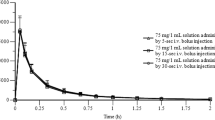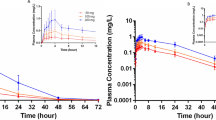Summary
The pharmacodynamics and pharmacokinetics of the combination of furosemide retard (30 mg)/triamterene (50 mg) were compared with furosemide (30 mg) in 18 healthy male volunteers aged 39.3±6.3 years. After the administration of furosemide the onset of its effect was very rapid, reaching a maximum between 1.5 to 3 h, and followed by rebound after 9 to 10.5 h. In contrast the combination furosemide retard/triamterene showed a protracted course with a duration of effect up to 12 h. The general effect over 12 h of the two preparations was equivalent with respect to the excretion of urine, sodium, chloride and calcium, but the combination caused significantly less excretion of potassium (p≤0.05) than furosemide. After a lag-phase of 33.9±5.4 min the maximum plasma concentration of furosemide was reached after 3.47±0.66 h, and the elimination half-life was approximately 2 h. After a lag-phase of 33.0±17.8 min the maximum plasma concentration of the main metabolite of triamterene, the OH-TA sulphuric acid ester, was reached after 1.7±0.59 h, and its elimination half-life amounted to 1.25±0.37 h. Because of the sustained release of furosemide from the retard-formulation, its principal pharmacokinetic parameters were better adapted to those of triamterene. The consequences were not only a protracted effect but also an improved electrolyte profile, especially with regard to reduced loss of potassium. In the case of renal insufficiency, however, the potassium level in serum might be increased to an undesirable extent.
Similar content being viewed by others
References
Aperia AC (1969) Tubular sodium reabsorption and the regulation of renal hemodynamics. The effect of chlorothiazide on renal vascular resistance. Acta Physiol Scand 75: 360
Beck OA, Hochrein H (1977) Serumkaliumspiegel und Herzrhythmusstörungen beim akuten Myokardinfarkt. Z Kardiol 66: 187
Ebihara A, Tawara K, Oka T (1983) Pharmacodynamic and pharmacokinetic study of a slow-release formulation of furosemide in man. Arzneimittelforsch 33: 163
Ehrly AM (1975) Ödemausschwemmung und Thrombose. Med Welt 26: 1877–1882
Fülgraff G, Wolf K, Adelmann J, Krieger A-K (1969) Zum Wirkungsmechanismus von Diuretica. Die Wirkung von Furosemid auf den O2-Verbrauch der Niere. Naunyn Schmiedeberg's Arch Pharmakol Exp Pathol 263: 485
Heidland A, Klütsch K, Suzuki F (1964) Nierenhämodynamik, Wasser- und Elektrolytausscheidung nach 4-Chlor-N-(2-furylmethyl)-5-sulfamoyl-anthranilsäure. Arzneimittelforsch 14: 713–716
Kilcoyne MM, Schmidt DH, Cannon PJ (1973) Intrarenal blood flow in congestive heart failure. Circulation 47: 786
Klein H (1975) Triamteren: Klinische Pharmakologie, Indikationsbereiche und Nebenwirkungen eines Diuretikums. Therapiewoche 25: 5135–5142
Knauf H, Mutschler E (1980) Zur Pharmakokinetik der Diuretika. Schwerpunktmedizin 3: 42–45
Knauf H, Mutschler E, Völger K-D, Wais U (1978) Pharmakologische Wirksamkeit von Phase-I- und Phase-II-Metaboliten des Triamteren. Arzneimittelforsch 28: 1417
Knauf H, Wais U, Albiez G, Lübcke R (1976) Kaliumsparer: Einseitige Diuretika, aber ideale Kombinationspartner. Therapiewoche 26: 5384–5387
Lehmann K (1965) Trennung, Isolierung und Identifizierung von Stoffwechselprodukten des Triamteren. Arzneimittelforsch 15: 812
Leilich G, Knauf H, Völger K-D (1979) Influence of triamterene and hydroxytriamterene sulfuric acid ester in diuresis and saluresis of rats after oral and intravenous application. Naunyn Schmiedberg's Arch Pharmacol 307, R48
Meng K, Loew D (1974) Diuretika — Chemie, Pharmakologie, Therapie. Thieme, Stuttgart
Neumann D, Schmidt G (1977) Diuretische und saluretische Wirkung des Bemetizid und des Triamteren im Vergleich zu verschiedenen Kombinationen beider Substanzen. Arzneimittelforsch 27: 559–562
Reploh HD, Gradaus D, Bender F, Siepmann A (1974) Die Beeinflussung der Nierendurchblutung durch Furosemid. Med Monatsschr 28: 155–157
Reubi F (1978) Diuretika und Kaliumverluste. Schweiz Med Wochenschr 108: 1513–1514
Rupp W (1980) Some aspects of the clinical pharmacology of furosemide. Arch Int Pharmacodyn Ther 245: 119–129
Schäfer GE, Werner E, Kober G, Kaltenbach M (1977) Serumund Gesamtkörper-Kalium unter Chlortalidon und Hydrochlorothiazid: ihre Beeinflussung durch eine kombinierte Behandlung mit Triamteren. Dtsch Med Wochenschr 102: 1838–1843
Truninger B (1978) Diuretika — Kaliumverluste — Kaliummangel und Kaliumsubstitution. Schweiz Med Wochenschr 108: 1009–1012
Vorburger C (1964) Die akute Wirkung des Diuretikums Fursemid auf das Glomerulumfiltrat, die renale Hämodynamik, die Wasser-, Natrium-, Chlorid- und Kaliumausscheidung und auf den Sauerstoffverbrauch der Nieren. Klin Wochenschr 42 [17]: 833–839
Vorburger C (1971) Diuretika bei eingeschränkter Nierenfunktion. Internist 12: 345–351
Author information
Authors and Affiliations
Rights and permissions
About this article
Cite this article
Loew, D., Barkow, D., Schuster, O. et al. Pharmacokinetic and pharmacodynamic study of the combination of furosemide retard and triamterene. Eur J Clin Pharmacol 26, 191–195 (1984). https://doi.org/10.1007/BF00630285
Received:
Revised:
Accepted:
Issue Date:
DOI: https://doi.org/10.1007/BF00630285




